#Nepal-China border
Text
Forging Friendships on the Tracks: The China-Nepal Railway Project Strengthens Bonds Beyond Borders
Before assuming the role of the Nepalese ambassador to China, Bishnu Pukar Shrestha enjoyed an extensive career in education and human rights. This background provides him with a unique lens through which he views international matters. When discussing the Belt and Road Initiative, he emphasized its deep philosophical significance, evoking the historical importance of the ancient Silk Road.…

View On WordPress
#Belt and Road Initiative#Bishnu Pukar Shrestha#China-Nepal connectivity#China-Nepal cross-border railway project#Chinese market#cultural exchanges#international cooperation#organic produce
0 notes
Text
I'm gonna share a few thoughts.
>>> People who are very insistent (rightfully) that Hamas and the Palestinians are not the same, because it de-humanizes the latter, are the same people who take every quote an Israeli official makes about fighting Hamas, and attribute it as if it was said about fighting the Palestinians. It seems they're the ones who are conflating Hamas and the Palestinians, but only when it can be used to de-humanize Jews.
>>> The same people who rushed to provide the "context" that the Islamist terrorists massacred over 1,400 people in Israel on Oct 7 due to occupation, were very silent when two Swedish soccer fans were murdered by an Islamist terrorist in Belgium on Oct 16. The last time I checked, Sweden had never occupied any part of Tunisia. For that matter, Hamas murdered and kidnapped many foreigners working and studying in Israel. I'm also pretty sure Thailand, Nepal, China and the Philippines had never occupied Palestine.
>>> I've seen many people screaming that the number of aid trucks being brought into Gaza since Oct 7 is insufficient, because so far it has been less than 100 a day, and before Hamas' attack, it was 500 daily. These are the same people who have been comparing Gaza to a ghetto or concentration camp. I can't remember a single day when the Nazis allowed 500 aid trucks into the Warsaw Ghetto or the Dachau concentration camp.
>>> I've seen many people claiming that Israel warning the Palestinians to evacuate parts of Gaza is forced transfer. I did not see these people so much as acknowledging the existence of well over 500,000 Israelis, who have been evacuated due to Hamas and Hezbollah's on going attacks against Israel.
>>> These same people criticize Israel so much, did not post a single condemnation of Egypt, which refuses to allow Gazans a temporary refuge within its borders. Egypt has also used the "forced transfer" excuse to deny Palestinians a safe temporary shelter. When Ukrainians needed to leave their bombarded cities, I don't remember their neighboring countries refusing to accept them temporarily, because it would be "forced transfer."
>>> IDK if this anti-Israeli post has the worst take yet, but it is def a strong contender:

The same people who can't bring themselves to condemn Hamas without reservations, to admit that it's a terrorist organization, with the stated genocidal goal of killing ALL JEWS, are the ones invoking the memory of the genocide perpetrated against Jews to try and get others to come out against the only Jewish state, and one that was very much a needed refuge place for about two thirds of Holocaust survivors after what they had endured. When Hamas has literally kidnapped and murdered Holocaust survivors and their family members. When countless Jewish people have pointed out that Hamas' massacre was the deadliest assault on Jews since the Holocaust, and made many of them be reminded of its horrors.
To take the memory of the Holocaust and use it to attack Jews, including Holocaust survivors and their families, and most of all, to do it based on a narrative that is completely ignorant or deliberately dismissive of Jewish native rights in Israel, is unconscionable. This person and those who agreed with them, they're guilty of exactly what they accuse others of. They've bought into the anti-Israeli propaganda that allows them to look at kidnapped Jewish babies and tear down their posters, to ignore Jewish students having to hide from anti-Israeli mobs, and to explain that the murdered Holocaust survivors deserved it, de-humanizing and victim blaming them a second time, just as the Nazis and their collaborators did.
(for all of my updates and ask replies regarding Israel, click here)
#israel#israeli#israel news#israel under attack#israel under fire#terrorism#anti terrorism#antisemitism#hamas#antisemitic#antisemites#jews#jew#judaism#jumblr#frumblr#jewish#holocaust#shoah#resources
603 notes
·
View notes
Text
In the waters of the South China Sea, Chinese coast guard vessels have clashed with Philippine ships. In the air above the Taiwan Strait, Chinese warplanes have challenged Taiwanese jet fighters. And in the valleys of the Himalayas, Chinese troops have fought Indian soldiers.
Across several frontiers, China has been using its armed forces to dispute territory not internationally recognized as part of China but nevertheless claimed by the Chinese Communist Party (CCP).
In August 2023, Beijing laid out its current territorial claims for the world to see. The new edition of the standard map of China includes lands that are today a part of India and Russia, along with island territories such as Taiwan and comprehensive stretches of the East and South China Seas that are also claimed by Brunei, Indonesia, Japan, Malaysia, the Philippines, and Vietnam.
China often invokes historical narratives to justify these claims. Beijing, for example, has said that the Japanese-administered Senkaku Islands, which it claims under the name of the Diaoyu Islands, “have been an inherent territory of China since ancient times.” Chinese officials have used the same words to back China’s right to parts of the northeastern Indian state of Arunachal Pradesh. The Chinese government also claims that its sovereignty over the South China Sea is based on its own historic maritime maps.
However, in certain periods since ancient times China has also held sway over other states in the region—Mongolia, North Korea, South Korea, and Vietnam. Yet Beijing is currently not laying claim to any of these.
Instead, Beijing has embraced a selective irredentism, wielding specific chapters of China’s historical record when they suit existing aims and leaving former Chinese territories be when they don’t. Over time, as Beijing’s interests and power relations have shifted, some of these claims have faded from importance, while new ones have taken their place. Yet for Taiwan, Chinese claims remain unchanged, as the fate of the island state is tied to the very legitimacy of the CCP as well as the vitality of Chinese President Xi Jinping’s political vision.
Many of the CCP’s territorial claims have roots in the 19th and 20th centuries during the late rule of the Qing Dynasty. Following diplomatic pressure and repeated military defeats, the Qing Dynasty was forced to cede territory to several Western colonial powers, as well as the Russian and Japanese empires. These concessions are part of what are known in China as the “unequal treaties,” while the 100 years in which the treaties were signed and enforced are known as the “century of humiliation.” These territorial losses eventually passed from the dynasty to the Republic of China and then, following the Chinese Civil War, to the CCP. As a result, upon the CCP’s establishment of the People’s Republic of China in 1949, the new Chinese state inherited outstanding territorial disputes with most of its neighbors.
But despite the humiliation the Qing Dynasty’s losses had caused, the CCP proved willing to compromise and reduce its territorial aims during times of high internal unrest. Following the Tibetan uprising in 1959, for instance, the CCP negotiated territorial settlements with countries bordering the Tibet region, including Myanmar, Nepal, and India. Similarly, when unrest rocked the Uyghur region in the 1960s and ‘90s, Beijing pursued territorial compromises with several bordering countries such as Afghanistan, Kazakhstan, Kyrgyzstan, and Tajikistan. In the aftermath of the Great Leap Forward in the early 1960s and the 1989 Tiananmen Square Massacre, the CCP also pursued territorial settlements with Mongolia, Laos, and Vietnam in the hopes of securing China’s borders during times of domestic instability. Instead of pursuing diversionary wars, the CCP relied on diplomacy to settle border and territory disputes.
But China has changed quite a lot since then. In recent years, the CCP has avoided the inflammatory domestic political chaos of previous decades, and its once-tentative hold over border regions, such as Tibet and the Uyghur region, has been replaced by an iron grip. With this upper hand, the CCP has little incentive to pursue peaceful resolutions to remaining territorial disputes.
“China’s national power has increased significantly, reducing the benefits of compromise and enabling China to drive a much harder bargain,” said M. Taylor Fravel, a political science professor at the Massachusetts Institute of Technology.
In this context, the CCP has expanded its irredentist ambitions. After the discovery of potential oil reserves around the Senkaku Islands, and the United States’ return of the islands to Japan in the 1970s, Beijing drew on its historical record to lay claim to the islands, even though it had previously referred to them as part of the Japanese Ryukyu Islands. Similarly, though Beijing and Moscow settled a dispute over Heixiazi Island, located along China’s northeastern border, in 2004, the 2023 map of China depicted the entire island (ceded, along with vast Pacific territories, by the Qing Dynasty to the Russian Empire in 1860) as part of its domain, much to the ire of the Russian Foreign Ministry.
Collin Koh Swee Lean, a senior fellow with the S. Rajaratnam School of International Studies at the Nanyang Technological University in Singapore, argues that the Chinese mapping of Heixiazi Island shows that Beijing holds on to certain core interests and simply waits for the opportune time to assert them.
“Given the current context of the war in Ukraine and Russia’s increased dependence on China, it might have appeared to Beijing that it has the chips in its pockets because, after all, Moscow needs Beijing more than the other way around,” Koh said on the German Marshall Fund’s China Global podcast.
This raises the question of whether territorial disputes that were settled during times of CCP weakness can be revisited and become subject to irredentist ambitions should power balances shift in China’s favor.
According to Steve Tsang, the director of the China Institute at the University of London’s School of Oriental and African Studies, there is currently a limit to how far the CCP will push territorial claims against Russia, since President Xi will need Russian support to sustain his grand ambitions for Chinese leadership on the global stage.
Although it would be a long shot, even Russia may not be safe from these ambitions indefinitely. Given that large swaths of Russia’s Pacific territories were part of China until 1860, “China could claim back the Russian Far East when it deems the time is right,” Tsang said. Such control would grant Beijing unrestricted access to the region’s abundance of coal, timber, tin, and gold while moving it geographically closer to its ambition of becoming an Arctic power.
While there is plenty of historical evidence pointing to former Chinese control over the southeastern portion of the Russian Far East, the historical record is less unequivocal about Chinese control over Taiwan. Anything resembling mainland Chinese control over Taiwan was not established until after 1684 by the Qing Dynasty, and even then central authority remained weak. In 1895, the Qing Dynasty ceded Taiwan to the Empire of Japan following the First Sino-Japanese War, and by the time Chinese authority was restored in 1945, Taiwan had undergone several decades of Japanization.
These details have not prevented the CCP from claiming that Taiwan has been an inalienable part of China since ancient times. Yet more than any other irredentist claim, Xi has made unification with Taiwan a major component of his vision to rejuvenate the Chinese nation.
Unification, however, has little to do with ancient history and more to do with the challenge that Taiwan presently poses to Xi’s aims, according to Chong Ja Ian, an associate professor who teaches about Chinese foreign policy at the National University of Singapore.
“The CCP pursues a Chinese nationalism that emphasizes unity and homogeneity centered around the CCP leadership while they also often claim that their single-party rule is acceptable to Chinese people,” Chong said.
In contrast, Taiwan holds free elections in which multiple political parties compete for the favor of a people that have increasingly developed an identity distinct from mainland China.
“The Taiwanese experience is a clear affront to the CCP narrative,” Chong said.
Control over Taiwan is also attractive to Beijing because it is key to unlocking the Chinese leadership’s broader ambition of maritime hegemony in waters where almost half of the world’s container fleet passed through in 2022.
As with the case of Taiwan, the CCP’s historical arguments regarding its claims on island groups and islets in the East and South China Seas are likewise much weaker than many of its land-based claims.
Instead, Chinese territorial intransigence in the maritime arena is more about a strategic shift in the value of the seas around China, Fravel said.
Today, it has been estimated that more than 21 percent of global trade passes through the South China Sea. And beneath these waters are not only subsea cables that carry sensitive internet data but also vast estimated reserves of oil and natural gas.
Although it may say otherwise, Beijing’s unwillingness to let up on its tenuous territorial maritime claims suggests that China is pursuing long-held ambitions and global aspirations rather than attempting to reverse past losses. So long as the CCP wields its historical record selectively and changeably to serve its aims—and is willing to back its claims up with military action—China’s neighbors will remain at risk.
18 notes
·
View notes
Text
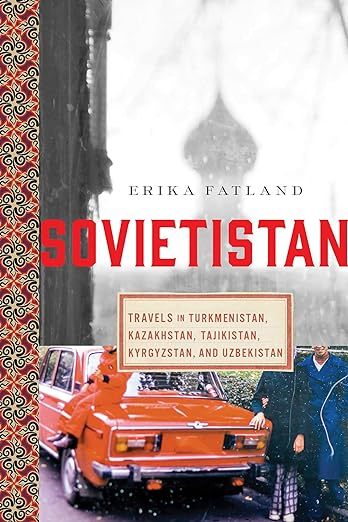
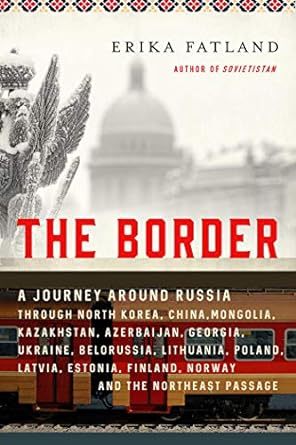
I've had these books sitting around for a couple of years now, but I finally picked up Erika Fatland's Sovietistan: Travels in Turkmenistan, Kazakhstan, Tajikistan, Kyrgyzstan, and Uzbekistan (BOOK | KINDLE | AUDIO) yesterday and I am burning through it and didn't even want to put it down long enough to post this. It's a good bet that any book that starts with a chapter about endlessly fascinating Turkmenistan and its crazy post-Soviet dictators -- the late, utterly ridiculous "Turkmenbashi" and the horse-obsessed dentist now in power -- is going to immediately capture my attention. The bizarre personality cults built around the dictators of Turkmenistan might actually be the one thing to shame Donald Trump because he'd be so envious of their audacity.
While I don't want my journey with Sovietistan to end as quickly as it's going to, I'm glad I also have Erika Fatland's book The Border: A Journey Around Russia Through North Korea, China, Mongolia, Kazakhstan, Azerbaijan, Georgia, Ukraine, Belarus, Lithuania, Poland, Latvia, Estonia, Finland, Norway, and the Northeast Passage (BOOK | KINDLE) ready to immediately dive into afterwards. I'm also going to need to get her newest book High: A Journey Across the Himalaya Through Pakistan, India, Bhutan, Nepal, and China (BOOK | KINDLE) to follow The Border. The author, Erika Fatland, is from Norway and speaks eight languages, so she's not completely lost in these wildly different and remote former Soviet satellite republics and her writing is vivid and funny (all three books are translated into English by Kari Dickson, so cheers to her, as well). I don't read a ton of books that fall in the genre of travel writing, but I might have to if there are more like this!
#Books#Book Recommendations#Book Suggestions#Erika Fatland#Sovietistan#The Border#High#Former Soviet Union#Soviet Union#Kazakhstan#Turkmenistan#Tajikistan#Kyrgyzstan#Uzbekistan#Travel Writing#Travel Writers#Former Soviet Republics#Turkmenbashi#Gurbanguly Berdimuhamedow#Saparmurat Niyazov#Dictators#Dictatorships#Personality Cults#Cults of Personality#Turkmen Dictators#Central Asia#History#Politics
28 notes
·
View notes
Text

Source: LEARN Geology
𝗠𝗮𝗿𝗶𝗻𝗲 𝗟𝗶𝗺𝗲𝘀𝘁𝗼𝗻𝗲: 𝗧𝗵𝗲 𝗛𝗶𝗴𝗵𝗲𝘀𝘁 𝗥𝗼𝗰𝗸𝘀 𝗶𝗻 𝘁𝗵𝗲 𝗣𝗹𝗮𝗻𝗲𝘁
Everest Range, 𝗡𝗲𝗽𝗮𝗹 and 𝗧𝗶𝗯𝗲𝘁, 𝗖𝗵𝗶𝗻a
27°59'17"N / 086°55'30"E
𝙂𝙚𝙤𝙡𝙤𝙜𝙞𝙘𝙖𝙡 𝙋𝙚𝙧𝙞𝙤𝙙:
Middle 𝗢𝗿𝗱𝗼𝘃𝗶𝗰𝗶𝗮𝗻 (𝗗𝗮𝗿𝗿𝗶𝘄𝗶𝗹𝗶𝗮𝗻)
𝘿𝙚𝙨𝙘𝙧𝙞𝙥𝙩𝙞𝙤𝙣:
Mount Everest is 𝗘𝗮𝗿𝘁𝗵'𝘀 𝗵𝗶𝗴𝗵𝗲𝘀𝘁 𝗺𝗼𝘂𝗻𝘁𝗮𝗶𝗻 above sea level, located in the Mahalangur Himal sub-range of the Himalayas. The China–Nepal border runs across its summit point. Its elevation of 𝟴,𝟴𝟰𝟴.𝟴𝟲 𝗺 was most recently established in 2020 by the Chinese and Nepali authorities.
𝗚𝗲𝗼𝗹𝗼𝗴𝗶𝗰𝗮𝗹 𝗗𝗲𝘀𝗰𝗿𝗶𝗽𝘁𝗶𝗼𝗻:
The 𝘀𝘂𝗺𝗺𝗶𝘁 of Mount Everest, the 𝗵𝗶𝗴𝗵𝗲𝘀𝘁 𝗽𝗼𝗶𝗻𝘁 on Earth, was a 𝘀𝗲𝗮 𝗳𝗹𝗼𝗼𝗿 once. 𝗜𝘀𝗻'𝘁 𝘄𝗼𝗻𝗱𝗲𝗿𝗳𝘂𝗹?. The highest rock on Earth, marking the summit of Mount Everest, are 𝗢𝗿𝗱𝗼𝘃𝗶𝗰𝗶𝗮𝗻 𝗟𝗶𝗺𝗲𝘀𝘁𝗼𝗻𝗲𝘀, deposited in a warm, shallow water sea some 𝟰𝟱𝟬 𝗠𝗮 𝗮𝗴𝗼.
These rocks deposited in an 𝗮𝗻𝗰𝗶𝗲𝗻𝘁 𝗧𝗲𝘁𝗵𝘆𝗮𝗻 𝗢𝗰𝗲𝗮𝗻 were thrust and 𝘂𝗽𝗹𝗶𝗳𝘁𝗲𝗱 into their present commanding position when 𝗜𝗻𝗱𝗶𝗮𝗻 𝗽𝗹𝗮𝘁𝗲 𝗰𝗼𝗹𝗹𝗶𝗱𝗲𝗱 with the 𝗔𝘀𝗶𝗮𝗻 𝗰𝗼𝗻𝘁𝗶𝗻𝗲𝗻𝘁 some 𝟱𝟱 𝗺𝗶𝗹𝗹𝗶𝗼𝗻 𝘆𝗲𝗮𝗿𝘀 𝗮𝗴𝗼.

𝗤𝗙: 𝗤𝗼𝗺𝗼𝗹𝗮𝗻𝗴𝗺𝗮 𝗙𝗼𝗿𝗺𝗮𝘁𝗶𝗼𝗻 (𝗘𝘃𝗲𝗿𝗲𝘀𝘁 𝗹𝗶𝗺𝗲𝘀𝘁𝗼𝗻𝗲𝘀):
It is the un-metamorphosed layer of limestone here called ‘QF’ for 𝗤𝗼𝗺𝗼𝗹𝗮𝗻𝗴𝗺𝗮 𝗙𝗼𝗿𝗺𝗮𝘁𝗶𝗼𝗻, which forms the 𝘀𝘂𝗺𝗺𝗶𝘁 of Everest. It is separated from the underlying Yellow Band layer by a low angle detachment fault.
𝗬𝗕:𝗬𝗲𝗹𝗹𝗼𝘄 𝗕𝗮𝗻𝗱:
This is the layered bedding. It is a limestone, formed from a shallow marine sediment, heated to become a 𝗺𝗮𝗿𝗯𝗹𝗲.
𝗘𝗦: 𝗘𝘃𝗲𝗿𝗲𝘀𝘁 𝗦𝗲𝗿𝗶𝗲𝘀:
It consists of 𝘀𝗲𝗱𝗶𝗺𝗲𝗻𝘁𝗮𝗿𝘆 rock which has been metamorphosed at reasonably high temperatures. It is separated from the underlying layer by a low angle almost horizontal fault.
𝗥𝗙: 𝗥𝘂𝗻𝗴𝗯𝗼𝗸 𝗳𝗼𝗿𝗺𝗮𝘁𝗶𝗼𝗻:
The Rungbok Formation consists of ‘LG’ Leuco- granite and gneiss.RF is a gneiss: rock partly melted and metamorphosed under high temperatures.
𝙁𝙤𝙨𝙨𝙞𝙡𝙨:
These rocks still contain the fossils of marine animals such as 𝗕𝗿𝗮𝗰𝗵𝗶𝗼𝗽𝗼𝗱𝘀, 𝗖𝗼𝗻𝗼𝗱𝗼𝗻𝘁𝘀 and 𝗖𝗿𝗶𝗻𝗼𝗶𝗱𝘀 that occupied tropical habitats during one of the most 𝗶𝗺𝗽𝗼𝗿𝘁𝗮𝗻𝘁 𝗶𝗻𝘁𝗲𝗿𝘃𝗮𝗹𝘀𝗹𝘀 in 𝗘𝗮𝗿𝘁𝗵'𝘀 history, the 𝗚𝗿𝗲𝗮𝘁 𝗢𝗿𝗱𝗼𝘃𝗶𝗰𝗶𝗮𝗻 𝗕𝗶𝗼𝗱𝗶𝘃𝗲𝗿𝘀𝗶𝗳𝗶𝗰𝗮𝘁𝗶𝗼𝗻 𝗘𝘃𝗲𝗻𝘁 (𝗚𝗢𝗕𝗘).
#himalayan#mounteverest#ordovician#limestone#nepal#india#tibet#indianplate#eurasianplate#geology#thrust#stratigraphy#sedimentology#petrology#structuralgeology#tethys#earthscience#iugs#unesco#geoheritage#knowledge
32 notes
·
View notes
Text
Tibetan Uprising Day 2024 and a Half-Forgotten Human Rights Disaster
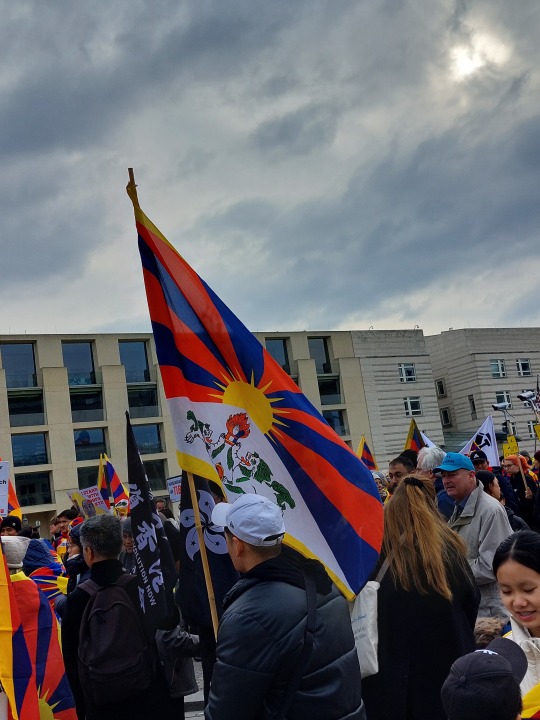
Protesters on Tibetan Uprising Day at Pariser Platz. Berlin, March 10, 2024. Photograph by me (Edith Haimberger). All rights reserved.
"Tibetans inside Tibet: We are with you!"
— sign at Berlin protest on March 10, 2024
The red, yellow and blue colours of Tibet's flag flew across the Pariser Platz square behind Brandenburg Gate on Sunday as some 80 protesters gathered for Tibetan Uprising Day.
Reeducation camps for Uyghur Muslims in China, more rarely developments in Hong Kong, and controversies around the Dalai Lama who is the spiritual leader of Tibetan Buddhists, may dominate international news headlines.
But the plight of inhabitants in the Tibetan region that the protestors portrayed in signs, speeches, and information panels yesterday is no longer common knowledge.
A youngish man in jeans and a puffer jacket, who was walking across the square on Sunday, asked the police officer beside him who had mentioned Tibet, "Was ist das?" ('What is it?') The police officer, at least, knew the answer.
Miniature History
In 1950 the Chinese People's Liberation Army invaded the remote region bordering Nepal. Ever since then, the autonomy or even the independence of Tibet has been hotly disputed, as well as the measures through which the ruling Chinese Communist Party governs the country. Tibetan Uprising Day marks the anniversary of a revolt in 1959.
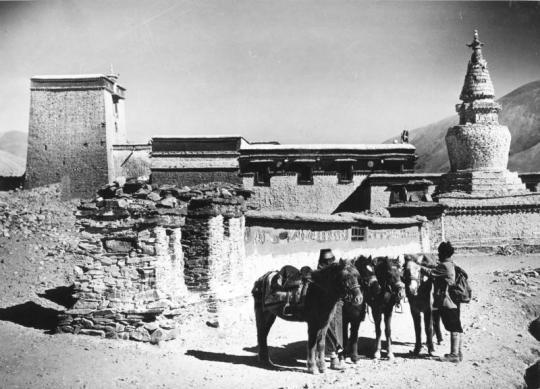
Image: "Tibetexpedition, Kloster in Samada." (Tibet Expedition, Convent [or Monastery] in Samada.) Photo taken by Ernst Krause in 1938.
Uploaded to Wikimedia Commons by the German Federal Archives.
'Many of us standing here today,' a speaker wearing traditional embroidered clothing told the crowd in Berlin, 'have never been in Tibet.'
Instead the protesters on Sunday were often exiles, many second-generation.
Their relatives in Tibet face systematic repression.
"Menschenrechte für Tibet"
"Freiheit für Tibet"
— 'Human rights for Tibet' and 'Freedom for Tibet.' Signs at the Berlin protest on March 10, 2024.
The Berlin speakers accused the Chinese Communist Party (CCP) of cultural genocide. Children as young as 5 years old are sent to residential boarding schools where they are educated as Chinese, while Tibetan language and culture are forbidden.
Monasteries and convents that were destroyed in the mid-20th century and only partly rebuilt in the 1980s remain vulnerable.
The Chinese government has been building massive hydroelectric dams in Tibet. Permission from Tibetans is not asked, a reporter from Tibet.tv said at the protest in Berlin. Instead, entire villages and monasteries, dating back even to the times where Europe was in the Middle Ages, are destroyed.
Local Tibetans who protest mega-dam projects are arrested and, at times, beaten.
A-Nya Sengdra, a nomad in Qinghai province, is in the middle of a 7-year prison sentence on charges like 'provoking trouble.' In a 2020 press release from the UN's Office of the High Commissioner for Human Rights, experts say that he had been active for example against "illegal hunting and poaching of endangered animals."
As his prison sentence continues, friends are worried for his health.
Outside Tibet, in his Indian exile of Dharamshala, the Dalai Lama has also spoken enigmatically about his successor as spiritual leader. He is 88 years old. The reincarnation of the Dalai Lama has a spiritual dimension for Tibetan Buddhists, but the Chinese Communist Party — a secular body —wants the next Dalai Lama to be approved by them first.
But, also explaining why Tibet is seldom in news headlines, it is difficult to obtain information from within the region. Writing for the Human Rights Watch website in 2022, an expert spoke of
draconian controls on the flow of information between Tibet and the outside world
*
The Heyday of International Awareness of Tibet
In the 1980s and 90s and early 2000s, Tibet was a cause célèbre.
Actress Sharon Stone and actor Richard Gere, who are Tibetan Buddhist, spoke out in favour of its independence.
The Tibet-inspired American fantasy film The Golden Child (1986) earned $149.4 million at the box office. In 1997, two films followed: Kundun, directed by Martin Scorsese, and Seven Years in Tibet .
When this reporter arrived in Germany in 2006, a string of Tibetan prayer flags crossed above a neighbourhood street.
Tourists were drawn to Tibet — this has not changed: it is estimated that 15 million of them visited in 2015.
But Tibet was not just famous in cultural spheres. In 1989, the Dalai Lama won the Nobel Prize for Peace.
*
Tenuous links exist between Tibetans in countries like Germany and Tibetans in the Tibetan Autonomous Region. But the CCP's surveillance extends beyond international borders. Telephone calls may be monitored, participation in protests by Tibetans in exile become a problem for relatives.

Young women at the Tibetan protest in Berlin, Germany, speak out against the Chinese Communist Party's gathering of DNA as part of a surveillance programme. Photograph taken by me (Edith Haimberger), on Sunday, March 10, 2024. All rights reserved.
Surveillance within Tibet is so severe that human rights organizations and activists reported in 2022 that the CCP are gathering DNA on a large scale — of hundreds of thousands of people, including schoolchildren — to track dissidents.
*
The Tibet Initiative Deutschland and the Gesellschaft für bedrohte Völker, two non-governmental groups, co-organized the Berlin protest on March 10.
The Gesellschaft noted on their social media that German Chancellor Olaf Scholz will travel to China in April.
In Tibetan communities in the country and abroad there are conflicting opinions on how to resist the Chinese Communist Party. Peacefully, through classic forms of protest? Through self-immolation?
"We know through painful experience that freedom is never voluntarily given by the oppressor; it must be demanded by the oppressed."
— Quoted during the March 10 protest. From Martin Luther King, Jr.: Letter from a Birmingham Jail (1963) [Wikiquote]
A speaker from the Tibet Initiative Deutschland described his group's campaign to persuade municipalities across Germany to raise the flag of Tibet over their town halls for Tibetan Uprising Day in solidarity. Over 400, he said, had agreed.
Efforts at the federal level by the German chancellor, foreign minister, and others on behalf of minorities' civil and political rights, however, are apparently often undermined by German corporations.
A representative of the Gesellschaft für bedrohte Völker told the crowd in front of the German Foreign Ministry yesterday:
Corporations doing business within China — the German foreign ministry reports in its China-Strategie publication that there are 5,000 of these — lobby for silence, fearing financial losses.
5 notes
·
View notes
Text
Tagged by @deaths-accountant in this post! Thanks!
Relationship status: Single.
Favorite color: Orange! Orange is the best color.
Song stuck in my head: As a general rule, Super Mario World "Athletic" plays in my head on repeat. Might be a contender for "song I have spent the most net time listening to". Ah, Mario...
Last song I listened to: SCANDAL - Scandal Baby
Last thing I Googled:

Mostly I google things that I half remember to make sure I am remembering them right. For instance I didn't know the name of that Super Mario World theme off the top of my head. And for a post earlier I had to find that IRA statement on Margret Thatcher. And so on.
Dream trip: I may have posted about this before, but my dream trip (or, well, one of them) is probably to travel from Afghanistan to Southern China by way of the south side of the Himalayas. Start in Kandahar and then go up to Kabul, through the Khyber pass into Peshawar, then to Jammu and Kashmir, Himachal Pradesh, Uttarakhand (not sure exactly where I would visit in these places), go through Nepal, see various things and especially visit Kathmandu, then travel around the Assam/Nagaland/Arunachal Pradesh region and finally go north into China, probably ending in Chengdu.
This trip is uh, Not Feasible at the moment, as it probably involves crossing more contested borders than any other geographically coherent trip you could imagine. Although one could presumably make it worse by trying to go from their into South Korea by land. Anyway, I think I'll have to save this one for a different political climate.
8 notes
·
View notes
Text
An Exiled Publisher Creates a ‘Brotherhood Across Tibetans’
Bhuchung Sonam co-founded a press to nurture the writing of Tibetans, helping provide through literature a sense of home for a stateless population.

by Tenzin D. Tsagong
In the winter of 1982, Bhuchung Sonam left his home in Central Tibet. For five days, he trekked with his father across the Himalayas to the Nepali border. Only around 11 years old then, he knew little about what they were fleeing — China’s decades-long colonization of his homeland — and why. He also didn’t realize that he would never again see his homeland, his mother or his six siblings.
After arriving in Nepal, Sonam and his father made a pilgrimage to Buddhist sites in neighboring India, the home of the Dalai Lama and of many other Tibetans in exile. Without offering much explanation, the father then returned to Tibet, leaving Sonam under the care of a family friend.
Sonam never again saw his father, who died when he was in the 11th grade. He last spoke to his mother nine years ago. During the short call, she promised, “We will meet one more time.” But by then, Sonam knew that the political situation in Tibet made that nearly impossible.
Left in a foreign country without kin, he said, everything was new: bananas, dal, the notorious Indian monsoon. Writing and literature became a salve to help survive the loss of his homeland and his family. “The writing seals the pain,” he said. “It’s a process of negotiating this really harsh and endless barrage of obstacles and challenges that exile throws at you.”
READ MORE
#tibet#book publishing#dalai lama#homeland#librarians#writing#TibetWrites#literature#national identity
7 notes
·
View notes
Text
Bangladesh The Country ?
Bangladesh is >>
Bangladesh, is a country in South Asia. It is the eighth-most populous country in the world and is among the most densely populated countries with a population of nearly 170 million in an area of 148,460 square kilometres 57,320 sq mi. Bangladesh shares land borders with India to the north, west, and east, and Myanmar to the southeast. To the south, it has a coastline along the Bay of Bengal. It is narrowly separated from Bhutan and Nepal by the Siliguri Corridor, and from China by the mountainous Indian state of Sikkim in the north. Dhaka, the capital and largest city, is the nation's political, financial, and cultural centre. Chittagong, the second-largest city, is the busiest port on the Bay of Bengal. Khulna, Rajshahi and Sylhet are other major cities. The official language of Bangladesh is Bengali.

Bangladesh is Beautiful
#digital marketing#search engine optimization#seo#social media marketing#youtube marketing#youtube#methunsingh#methunsingh24#bangladesh#dhaka#local#barisal#barisalcity#digitalmarketar
5 notes
·
View notes
Text
youtube
A few countries have rejected China’s new 2023 standard map because they think it oversteps China’s boundaries. Here are all of China’s ongoing border disputes, mapped.
-- Video Chapters --
0:00 Intro
4:39 The New Map
5:13 Kashmir
6:44 Nepal
7:34 Bhutan
9:36 Arunachal Pradesh
10:47 Myanmar
11:24 South China Sea
13:21 Senkaku Islands
13:49 Taiwan
14:59 Russia
15:22 Conclusion
15:56 Credits
3 notes
·
View notes
Text
PM Pushpa Kamal Dahal likely to sign power pact during his visit to China
Nepal’s Prime Minister Prachanda’s visit to China in September could result in a power trading, according to sources in Kathmandu. A cross-border transmission line between China and Nepal via the district of Rasuwa is expected to be agreed upon. Nepal also wants to learn best practices in agriculture from China.
Nepal Prime Minister Pushpa Kamal Dahal Prachanda’s China visit in September could…
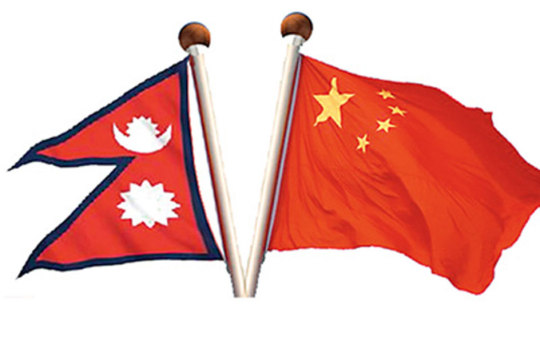
View On WordPress
0 notes
Text
Most Stunning Borders in the World

Netherlands and Belgium

Norway and Sweden

Iguazu Argentina and Brazil

United States and Mexico

Afghanistan and Pakistan

Italy and Switzerland. Along the border of Italy and Switzerland high up in the alps sits a single hut used as a research center for low temperature climates

Egypt and Israel
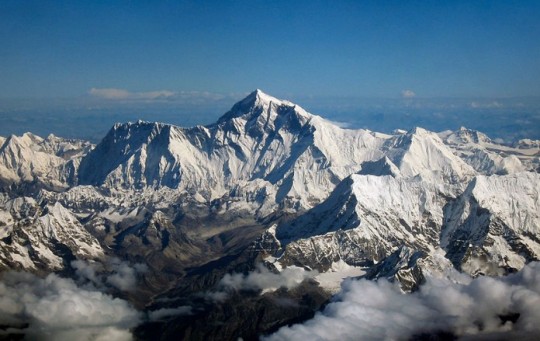
Nepal and China. Mount Everest sits right on the border of Nepal and China making it one of the highest international borders that exists
January 10 2023
16 notes
·
View notes
Text
Nepal
Nepal initially existed as a distributed power. Prithivi Narayan Shah played a pivotal role in unifying and forming Greater Nepal. Throughout this historical period, various Ranas held sway as leaders, while numerous Shahs ascended the throne as kings. Despite the passage of many dynasties, Nepal managed to remain isolated from the rest of the world.
During the British rule in India, Nepalis sought employment beyond their borders, particularly in regions like Darjeeling and Assam controlled by the British. Nepal exhibited a rent-seeking mentality, desiring external rule and guidance. Unfortunately, a pervasive attitude emerged where individuals were reluctant to instigate change, contributing significantly to our challenges. The issue of brain drain became prominent in 1815 and escalated rapidly in the 1850s. Initially, it was fields like Darjeeling in India that attracted Nepalis due to British influence. However, in contemporary times, destinations such as Australia, the USA, and Dubai have become magnets for Nepali migrants.
The historical pattern in Nepal reveals a recurring cycle of distributed power, followed by centralized rule under a king, then a shift to democracy. Interestingly, it appears that democracy has gained favor among the populace. Nevertheless, Nepal consistently finds itself positioned between two influential countries, China and India, both examples of distinct development models—one democratic and the other more isolated from the global arena.
In contemplating the cyclical nature of events, it's crucial to recognize that in times of war, it's the soldiers who bear the brunt, not the kings.
The key to progress lies in fostering a mindset geared towards improvement rather than a mere desire for change.
2 notes
·
View notes
Text

Today's Objectum Waifu:
Mt. Everest in The Himalayas, along the China-Nepal border
18 notes
·
View notes
Note
i've met a lot of people with pet stufful, but i've never seen one in the wild. where are they native, and do they act differently in the wild versus in captivity?
It's not surprising you've never seen a Stufful in the wild, because they're quite rare! Stufful are native to the high latitudes around the border of Nepal and China, where they're known to hide in the local forests. Wild Stufful are much more secretive than their domestic counterparts - domestic Stufful can be quite outgoing!
28 notes
·
View notes
Text
Nepal was furious in 2019 when India published a map, including some of the areas claimed by Kathmandu in the western region, close to the border with China. The diplomatic wrangle escalated after Nepal also published its own map including those disputed areas. A few years before the map controversy, the ethnic Madhesi community in Nepal had blocked goods traffic from India as part of its 2015 protests for more rights. Though India denied it was behind the economic blockade, very few people in Nepal believed the denial.
Anbarasan Ethirajan, ‘Agnipath scheme: The pain of Nepal's Gurkhas over Indian army's new hiring plan’, BBC
2 notes
·
View notes